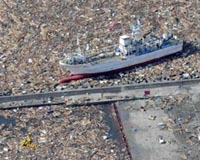| . |  |
. |
Tokyo (AFP) April 30, 2011 Constructing taller buildings and moving towns to higher ground may be the key to rebuilding Japan's devastated northeast coast, experts say, as the threat of future tsunamis shapes ideas for reconstruction. It was the monster wall of water, rather than March 11 magnitude 9.0 earthquake that spawned it, which tore through towns, destroying 300,000 homes and leaving 26,000 dead and missing. "What we agreed with Prime Minister Naoto Kan is that it is not simply enough to restore things as they were before," said Makoto Iokibe, chairman of the Council of Reconstruction, established by Kan. The daunting task of removing millions of tonnes of debris from destroyed homes and factories is the starting point for the remodelling of coastal towns in a region with an ageing population and fragile economy. But the concept of relocating towns is a sensitive issue for those whose livelihoods revolve around them. "It's actually a rather fundamental and philosophical question: where should people settle down? The sea is often the source of all their resources, so it's difficult to settle down away from it," said Yukio Nishimura, vice president of the University of Tokyo. "When you talk to those who were affected by the tsunami, some want to settle down to higher places or even move to a bigger town but others want to stay put," he said. The level of damage masks large regional disparities. The mountainous northernmost area paid the heaviest price, with numerous houses built on the narrow strip of land sandwiched between the sea and the mountains swept away. "Topographically, these areas are very vulnerable to tsunamis so we need to completely re-think town planning," said Jun Iio, who chairs a group of experts that submits proposals to the reconstruction council. Many specialists say detailed analysis of the topography of the 300 kilometres (200 miles) of devastated coastline on Honshu island should encourage rebuilding in higher places and further back from the sea. Another recommendation for schools, hospitals and town halls is to construct buildings that are at least four or five storeys tall to offer refuge from the giant waves when a tsunami strikes. Iokibe suggested the vast amount of rubble that forms the legacy of the March 11 disasters could be turned into landscaped hills. "In normal times people would able to use these parks for recreation," he said. "During disasters, they would be used as evacuation zones." Some fishing-related facilities will have to be relocated, he said. Experts point out that while the huge concrete walls facing the sea seen in many coastal towns and villages can help, they cannot guarantee safety. Several of the tsunami defences gave way under the force of the monster wave triggered by the earthquake, including the one that was supposed to protect the small fishing village of Taro, north of the city of Miyako, or they were simply not high enough. Based on experience gained after the earthquake that hit the western port city of Kobe in 1995, Iokibe estimates it will take 10 years to rebuild the devastated northeast. Japan faces a huge challenge in financing the mammoth rebuild without expanding a massive public debt of around 200 percent of gross domestic product. Ratings agency Standard & Poor's Wednesday warned that reconstruction costs could be as much as 50 trillion ($612 billion), higher than government estimates of up to 25 trillion yen. A first disaster budget of four trillion yen will be financed by cuts in welfare programmes but the prime minister has said a further reconstruction budget will be funded by a "sizeable" bond issue. For Nishimura, remembering the past is vital when rebuilding for the future. Northeastern Honshu had already experienced the two largest tsunamis to hit the country in modern history, the 1896 Meiji Sanriku and the 1933 Showa Sanriku and plans were made at the time. "Some were followed and some were forgotten. Some of these plans are still valid today," Nishimura said. "It is very difficult to keep this kind of memory. But we have to learn from previous tsunamis," the professor of urban planning said. "In some places, a few hundred metres (yards) away, houses are still standing and you can clearly see which areas are safer. If people can see it with their own eyes, they might start reconsider the situation" and be ready to move.
Share This Article With Planet Earth
Related Links Bringing Order To A World Of Disasters When the Earth Quakes A world of storm and tempest
 Japan to launch new major tsunami body search
Japan to launch new major tsunami body searchTokyo (AFP) April 24, 2011 Nearly 25,000 Japanese troops will Monday start a massive new search for bodies along the Pacific coast where some 12,000 people are still missing after the earthquake and tsunami, the military said. Some US forces will join the 24,800 soldiers and members of Japan's Coast Guard and police for the third search since the disaster struck on March 11, devastating towns along the northeast. ... read more |
|
| The content herein, unless otherwise known to be public domain, are Copyright 1995-2010 - SpaceDaily. AFP and UPI Wire Stories are copyright Agence France-Presse and United Press International. ESA Portal Reports are copyright European Space Agency. All NASA sourced material is public domain. Additional copyrights may apply in whole or part to other bona fide parties. Advertising does not imply endorsement,agreement or approval of any opinions, statements or information provided by SpaceDaily on any Web page published or hosted by SpaceDaily. Privacy Statement |